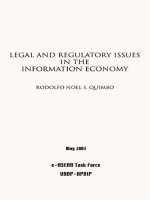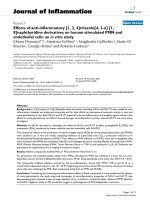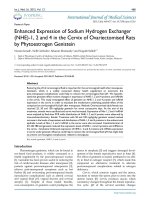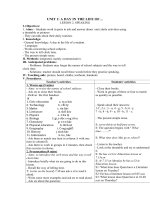1 2 4 in the lake (fiction)
Bạn đang xem bản rút gọn của tài liệu. Xem và tải ngay bản đầy đủ của tài liệu tại đây (35.68 KB, 2 trang )
In the Lake
by Irene Lotito
ELL Reader 1.2.4
Fiction
INTRODUCE THE BOOK
RESPOND
Activate Prior Knowledge/Build
Background Read the title, and invite children
to talk about lakes, ponds, rivers, or other bodies
of water that they have seen. Ask: What can you
do if you visit a lake? What might you see there?
Tell children this book describes life in a lake.
Answers to the Reader’s Inside Back Cover:
Preview/Use Text Features Preview the
reader by talking about the illustrations together
and naming the labeled items.
Preteach Vocabulary Review the highfrequency word that appears in this book: inside.
Introduce these key words from the book: lake
(p.1), dinosaurs (p. 2), fish (p. 2), and safe
(p. 8). Discuss these words and add them to a
Word Wall.
READ THE BOOK
Choose among these options for reading to
support children at all English proficiency levels.
Read Aloud Read the book aloud as children
follow along. Pause to verify comprehension and
to explain unfamiliar concepts.
Monitored Reading Have children read
aloud a few pages at a time. Use the following
questions to support comprehension:
• Page 2 What lives outside the lake?
(Dinosaurs live outside the lake.)
• Page 3 What lives inside the lake? (Fish
and plants live inside the lake.)
• Pages 4–8 What happens to yellow fish
and red fish? (Red fish wants to eat yellow
fish. Red fish goes away. Yellow fish is safe.)
Write About It
3. Children should draw a picture of the red or
the yellow fish. They should write about what
yellow fish or red fish does in the lake. Possible
response: The yellow fish swims. It jumps. It eats
a bug. (Characters)
Support writers at various English proficiency
levels.
Beginning Let children dictate what they
want to say as someone else records it.
Intermediate Have children tell partners
about their pictures before they write about
them.
Advanced Have children include at least
three details about their pictures.
Extend Language The opposite of little is big.
Encourage children to think of other opposite
pairs, such as up and down or hot and cold.
Answers to page 20:
Suggest that children look back at the book
for words or sentences they can write. Possible
responses:
Beginning: Yellow fish jumps to eat a bug.
Middle: Yellow fish hides and waits.
End: Yellow fish is safe.
Family Link Read aloud the Family Link activity
on page 20 before sending copies of the Study
Guide home with children. Later, have them talk
about a lake with which their family is familiar.
© Scott Foresman 1
Reread Have children reread the book with a
partner, in small groups, or independently. Have
them complete the Study Guide on page 20.
Talk About It
1. The fish in the lake jump, swim, eat, hide,
and wait. (Main Idea)
2. Possible response: In a lake, people can
swim, fish, and play.
ELL Readers Teaching Guide
Unit 2, Week 4 In the Lake
19
Study Guide
In the Lake
Name
• Read In the Lake again. What happens to yellow fish?
• Draw what happens to yellow fish in the beginning,
in the middle, and at the end. Write words or
sentences to go with your pictures.
Beginning (pages 4–5)
Middle (pages 6–7)
End (page 8)
Ask family members to tell about a lake they know.
Does it have fish?
20
In the Lake Unit 2, Week 4
ELL Readers Teaching Guide
© Scott Foresman 1
Family Link









